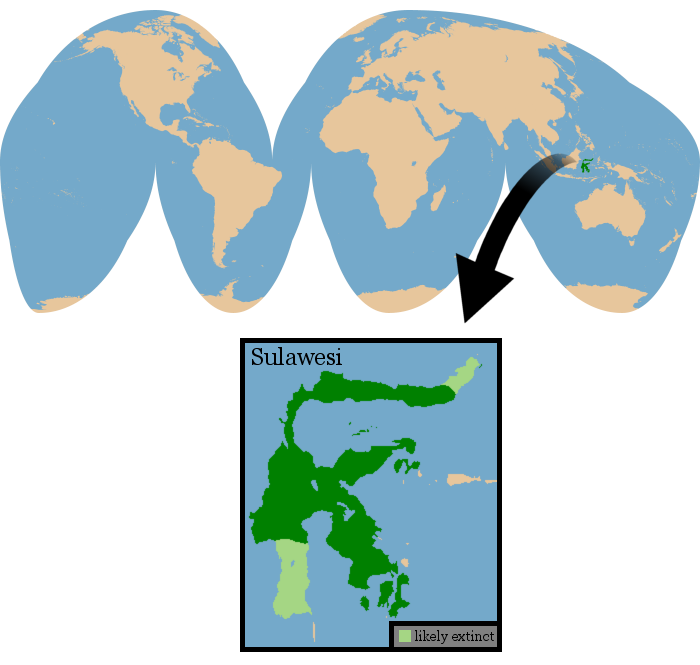Kingdom: |
Animalia Chordata Mammalia Artiodactyla Suiformes Suidae Suini Sus |
Common name:
Scientific name:
Other names: |
Sulawesi warty pig
Sus celebensis
Celebes pig, Sanglier de Célèbes, Celebesschwein |
Physical Characteristics
- Head and body length:
80-130 cm
- Shoulder height: 60-70 cm (males), females shorter
- Tail length: Unreported
- Adult weight: 40-70 kg
- Shoulder height: 60-70 cm (males), females shorter
Males are larger than females, but both sexes have short legs, a rounded back, and a long tufted tail. Adults are gray-black in color, sometimes with an infusion of red or yellow on the flanks. There is a short crest of thick black bristles on the crown of the head (and sometimes the nape of the neck), which extends into a dark dorsal stripe. The short face is generally dark, with a prominent band of yellow hair which crosses the snout in front of the eyes and a tuft of pale bristles on each cheek. Both sexes have three pairs of facial warts, but they are much more pronounced in males, and may dominate the faces of older animals. The ears are relatively small.
Similar species
-
- Babirusas (Babyrousa spp.) are the only other wild pigs to share the Sulawesi warty pig's range. Unlike the warty pig, babirusas have only sparse hair on their bodies; their faces are longer and narrow, and male babirusas have distinctive tusks that grow through the roof of their snouts.
- The Visayan warty pig (Sus cebifrons) has a similar pale snout band, but tends to be paler (grayer) in color and lacks prominent warts. The crest of males is much larger compared to the Sulawesi warty pig.
Reproduction and Development
- Gestation period:
Estimated around 4 months.
- Litter size: Typically 1-3, with isolated reports of up to 8 infants per litter.
- Weaning: Unknown.
- Sexual maturity: "Fully adult" by four years; maturity likely reached at 1.5 or 2 years.
- Life span: At least nine years (in captivity).
- Litter size: Typically 1-3, with isolated reports of up to 8 infants per litter.
Breeding likely occurs year round, but is not well studied; one report indicates a peak in births in April-May. Females create a birthing nest by digging up soil into a trough and covering this with grasses, leaves, and branches. At birth, infants have four broad yellowish stripes running from shoulder to rump separated by dark brown stripes, which are retained for at least six months. Juveniles, which are recognized by the absence of stripes and an overall reddish color, appear to remain with their mothers for at least one year.
Ecology and Behavior
Sulawesi warty pigs are most active in the morning (06:00-11:00) and afternoon (14:00-18:00), often spending the midday wallowing in mudholes which they dig up with their snouts. Dried mud is often rubbed off on tree trunks, which likely helps with skin care. Night is usually spend resting, but in areas with human activity this species often shows nocturnal activity. While on the move, groups are generally led by the dominant male. This species uses a halting gait when in open spaces (like salt licks), taking several steps and then freezing in position to assess their environment, breaking into a run if alarmed. Males may scent mark using secretions from facial glands, but the function of this behavior is unknown. Population densities in Sulawesi are highly variable, with estimates in the north (Panua Nature Reserve) being as low as 0.4 animals per km² but in parts of the southeast (Tanjung Peropa) densities of 23.5-34 animals per km² have been recorded.
- Family group:
Solitary or in groups of 2-9 animals, usually with one adult male, several females, and offspring.
- Diet: Omnivorous. Foliage, fallen fruits, and roots, supplemented with a variety of animal matter (fish, crustaceans, worms, insects, and carrion).
- Main Predators: Reticulated python.
- Diet: Omnivorous. Foliage, fallen fruits, and roots, supplemented with a variety of animal matter (fish, crustaceans, worms, insects, and carrion).
Habitat and Distribution

Conservation Status
- IUCN Red List:
Near Threatened (2008).
- CITES Listing: Not listed (2011).
- Threats: Hunting for meat, habitat destruction and fragmentation, and hybridization with domestic pigs.
- CITES Listing: Not listed (2011).
This species is still widespread in Sulawesi, being most abundant in the central, eastern, and south-eastern parts of the island. Hunting for meat in the north has caused noticeable declines.





